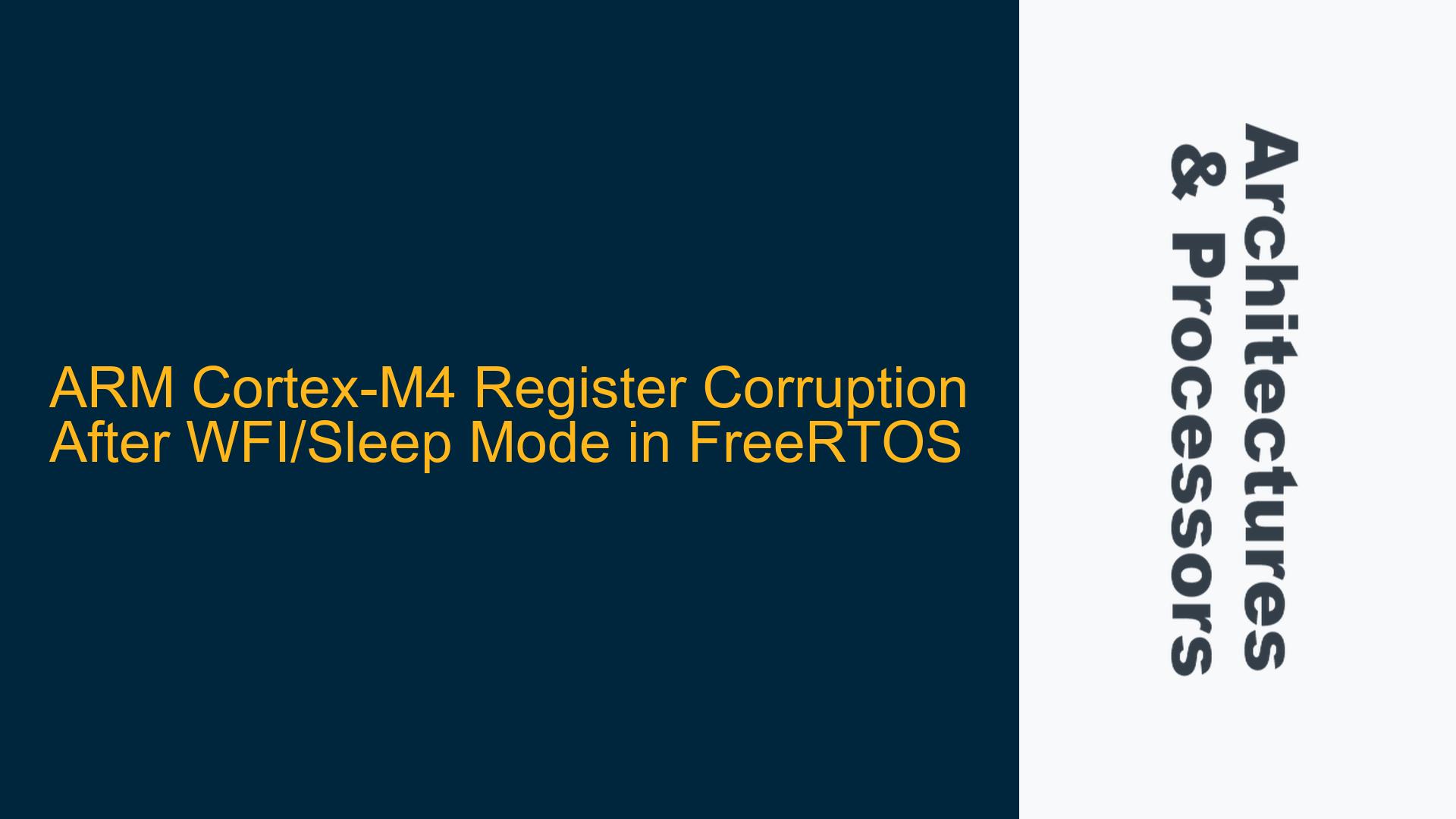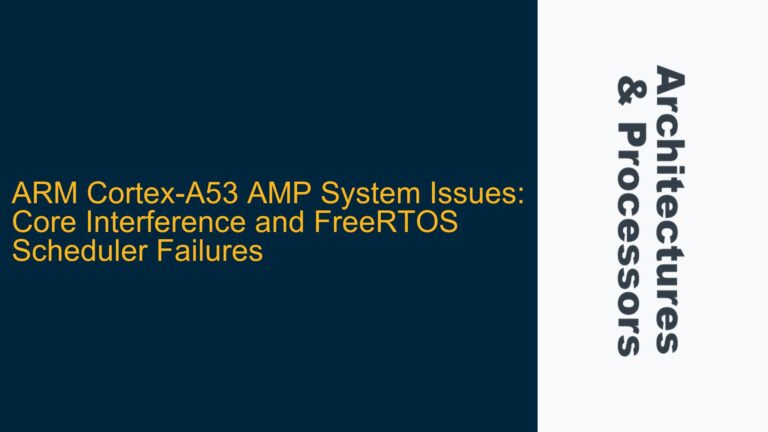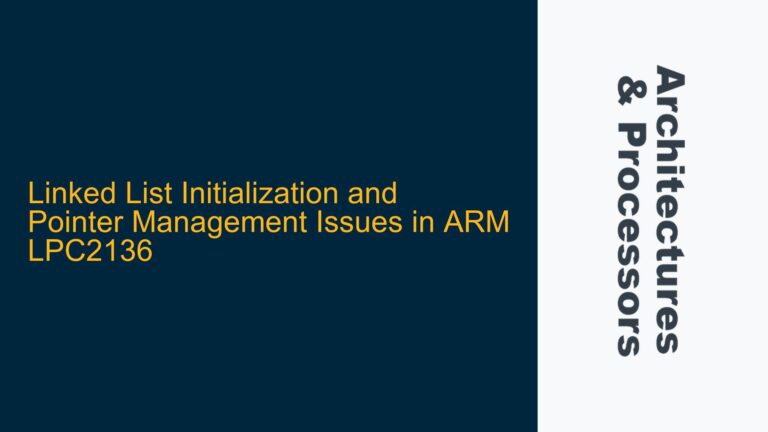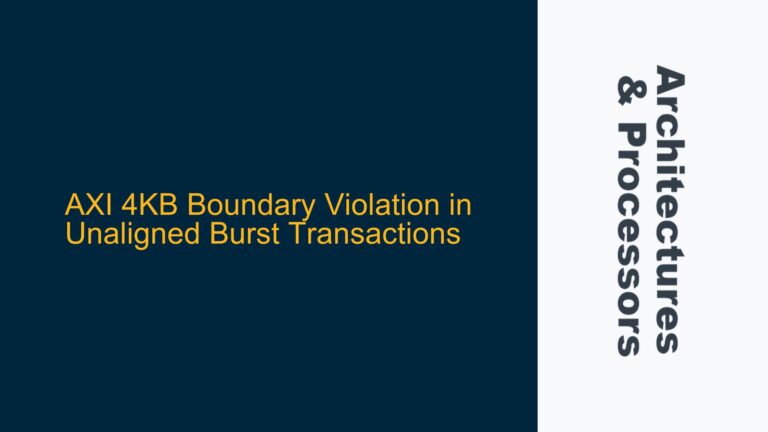ARM Cortex-M4 Register Corruption After WFI/Sleep Mode in FreeRTOS
Issue Overview
The core issue revolves around the corruption of the CPU register R7 after the Cortex-M4 processor exits sleep mode initiated by the WFI (Wait For Interrupt) instruction. This corruption manifests specifically during the first sleep cycle after system power-up, leading to an assertion failure in FreeRTOS. The assertion failure occurs because the xTickCount variable, which is critical for the RTOS scheduler, is incorrectly dereferenced due to the corrupted R7 register. The problem is observed only after a power-up event and not after a reset, making it particularly challenging to diagnose and reproduce.
The R7 register is used to hold a pointer to the xTickCount variable, which is essential for the RTOS tick management. After the WFI instruction, the R7 register is unexpectedly cleared to zero, causing the subsequent dereference to load an invalid value. This behavior is inconsistent and can sometimes be "fixed" by adding or removing code, or by placing a breakpoint and resuming execution, which further complicates the debugging process.
The issue is exacerbated by the fact that the corruption occurs only after the first sleep cycle post-power-up, suggesting a potential initialization or timing-related problem. The use of DSB (Data Synchronization Barrier) and ISB (Instruction Synchronization Barrier) instructions around the WFI instruction does not prevent the register corruption, indicating that the problem might be deeper than a simple synchronization issue.
Possible Causes
The corruption of the R7 register after the WFI instruction can be attributed to several potential causes, each of which requires careful consideration:
-
Power-Up Initialization Timing Issues: The Cortex-M4 processor may not be fully initialized or stable immediately after power-up. This could lead to unpredictable behavior when entering sleep mode for the first time. The timing of peripheral initialization, clock stabilization, and power supply settling could all contribute to this issue.
-
Cache or Memory Coherency Problems: Although the Cortex-M4 does not have a cache, memory coherency issues could still arise due to the interaction between the processor and the memory subsystem. The
DSBandISBinstructions are designed to ensure memory and instruction synchronization, but if the memory subsystem is not fully operational or is in an inconsistent state, these barriers may not be effective. -
Interrupt Latency or Priority Inversion: The
WFIinstruction puts the processor into a low-power state, waiting for an interrupt to wake it up. If an interrupt occurs immediately after theWFIinstruction but before the processor has fully entered the sleep state, it could lead to unexpected behavior. Additionally, if the interrupt priority is not correctly configured, it could cause priority inversion, leading to register corruption. -
Compiler or Toolchain Bugs: The issue could be related to the specific version of the compiler or toolchain being used. The
arm-freertos-eabi-gcctoolchain, particularly the version mentioned (GNU Tools for ARM Embedded Processors 6-2017-q3-update), might have bugs or optimizations that inadvertently affect the behavior of theWFIinstruction or the surrounding code. -
Hardware Errata or Silicon Bugs: The STM32F302CCT microcontroller, which is based on the Cortex-M4 architecture, might have hardware errata or silicon bugs that could cause register corruption under specific conditions. These issues are often documented in the microcontroller’s errata sheet and can be difficult to diagnose without thorough testing.
-
FreeRTOS Configuration or Implementation Issues: The FreeRTOS implementation, particularly the idle task and the sleep function, might have configuration or implementation issues that lead to register corruption. The interaction between the RTOS and the hardware, especially during low-power modes, can be complex and prone to errors.
Troubleshooting Steps, Solutions & Fixes
To address the issue of R7 register corruption after the WFI instruction, a systematic approach is required. The following steps outline a comprehensive troubleshooting and resolution process:
-
Verify Power-Up Initialization Sequence: Ensure that the power-up initialization sequence is correctly implemented and that all necessary peripherals, clocks, and power supplies are stable before entering sleep mode. This includes verifying the timing of the initialization code and ensuring that the processor is fully operational before executing the
WFIinstruction. -
Check Memory and Peripheral Configuration: Verify that the memory and peripheral configurations are correct and consistent with the microcontroller’s reference manual. This includes checking the memory map, peripheral clock enables, and any configuration registers that might affect the behavior of the
WFIinstruction. -
Review Interrupt Configuration: Ensure that the interrupt configuration is correct and that the interrupt priorities are properly set. This includes verifying the NVIC (Nested Vectored Interrupt Controller) settings and ensuring that no priority inversion can occur. Additionally, check that the interrupt handlers are correctly implemented and do not inadvertently modify the
R7register. -
Update Compiler and Toolchain: Consider updating the compiler and toolchain to a more recent version. The
arm-freertos-eabi-gcctoolchain has seen several updates since the 2017-q3 release, and newer versions might have fixed bugs or improved optimizations that could resolve the issue. -
Consult Hardware Errata: Review the STM32F302CCT microcontroller’s errata sheet for any known issues related to the
WFIinstruction or low-power modes. If a relevant errata is identified, implement the recommended workaround. -
Modify FreeRTOS Sleep Function: Modify the FreeRTOS sleep function to include additional safeguards around the
WFIinstruction. This could include adding additionalDSBandISBinstructions, or inserting a small delay before and after theWFIinstruction to ensure that the processor has fully entered and exited the sleep state. -
Implement Register Preservation: Implement a mechanism to preserve the
R7register before entering sleep mode and restore it after waking up. This could be done using inline assembly or by modifying the FreeRTOS port to save and restore the register context around theWFIinstruction. -
Debugging and Testing: Use a debugger to step through the code and monitor the
R7register before and after theWFIinstruction. This can help identify the exact point at which the register is corrupted. Additionally, perform extensive testing under different conditions to ensure that the issue is fully resolved.
Example Code Modifications
The following code modifications demonstrate how to implement some of the suggested fixes:
// Original Sleep Function
void vPortSuppressTicksAndSleep( TickType_t xExpectedIdleTime )
{
volatile uint32_t test5257;
volatile uint32_t test5258;
__asm volatile("mov %0, r7" : "=r" (test5257));
if( xModifiableIdleTime > 0 )
{
__asm volatile ( "dsb" ::: "memory" );
__asm volatile ( "wfi" );
__asm volatile ( "isb" );
}
configPOST_SLEEP_PROCESSING( xExpectedIdleTime );
__asm volatile ("nop" ::: "memory");
__asm volatile ( "dsb" );
__asm volatile ( "isb" );
__asm volatile("mov %0, r7" : "=r" (test5258));
}
// Modified Sleep Function with Additional Safeguards
void vPortSuppressTicksAndSleep( TickType_t xExpectedIdleTime )
{
volatile uint32_t test5257;
volatile uint32_t test5258;
__asm volatile("mov %0, r7" : "=r" (test5257));
if( xModifiableIdleTime > 0 )
{
__asm volatile ( "dsb" ::: "memory" );
__asm volatile ( "nop" ); // Small delay before WFI
__asm volatile ( "wfi" );
__asm volatile ( "nop" ); // Small delay after WFI
__asm volatile ( "isb" );
}
configPOST_SLEEP_PROCESSING( xExpectedIdleTime );
__asm volatile ("nop" ::: "memory");
__asm volatile ( "dsb" );
__asm volatile ( "isb" );
__asm volatile("mov %0, r7" : "=r" (test5258));
}
Conclusion
The corruption of the R7 register after the WFI instruction in the Cortex-M4 processor is a complex issue that requires a thorough understanding of both the hardware and software interactions. By systematically addressing potential causes and implementing targeted fixes, it is possible to resolve the issue and ensure reliable operation of the FreeRTOS-based system. The key is to carefully analyze the initialization sequence, interrupt configuration, and toolchain behavior, while also considering any hardware-specific errata that might contribute to the problem.






